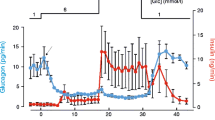Summary
Transmembrane Ca2+ currents were investigated by means of a whole-cell clamp technique in a hamster glucagon-secreting tumor cell line (ITC-1). Two types of Ca2+ current were identified in ITC-1 cells. The low-threshold and transient (T-type) current became detectable above the potential level around −60 mV and decayed rapidly with an inactivation time constant of 95 ms (at −40 mV and 23°C), while the high-threshold and long-lasting (L-type) one was activated by depolarization more positive to −30 mV with non-inactivating kinetics. The voltage dependence and kinetics of these currents were identical to those reported in guinea-pig pancreatic α2 cells. Both currents were augmented by equimolar substitution of Ca2+ with Ba2+ and completely abolished by adding 1 μM La3+. Phenytoin, a well known anti-epileptic drug and a postulated T-type specific Ca2+ current antagonist, surprisingly blocked the L-type current without affecting the T-type current in ITC-1 cells. While phenytoin antagonized the L-type Ba2+ current selectively, 60% of the current remained even in supramaximal concentration range over 500 μM. The residual component of the L-type current was completely abolished by adding nifedipine.
Similar content being viewed by others
References
Adler EM, Yaari Y, David G, Selzer ME (1986) Frequency-dependent action of phenytoin on lamprey spinal axons. Brain Res 362:271–280
Ashcroft FM, Kelly RP, Smith PA (1990) Two types of Ca channel in rat pancreatic β-cells. Pflugers Arch 415:504–506
Bean BP (1985) Two kinds of calcium channels in canine atrial cells: Differences in kinetics, selectivity, and pharmacology. J Gen Physiol 86:1–30
Bean BP (1989) Classes of calcium channels in vertebrate cells. Annu Rev Physiol 51:367–384
Cohen MS, Bower RH, Fidler SM, Johnsonbaugh RE, Sode J (1973) Inhibition of insulin release by diphenylhydantoin and diazoxide in a patient with benign insulinoma. Lancet 1:40–41
Fleckenstein A (1983) History of calcium antagonists. Circ Res 52 [Suppl 1]:3–16
Fox AP, Nowycky MC, Tsien RW (1987) Kinetic and pharmacological properties distinguishing three types of calcium currents in chick sensory neurones. J Physiol 394:149–172
Gerich JE, Charles MA, Levin SR, Forsham PH, Grodsky GM (1972) In vitro inhibition of pancreatic glucagon secretion by diphenylhydantoin. J Clin Endocrinol Metab 35:823–824
Griffith WH, Taylor L (1988) Phenytoin reduces excitatory synaptic transmission and post-tetanic potentiation in the in vitro hippocampus. J Pharmacol Exp Ther 246:851–858
Harris RA, Jones SB, Bruno P, Bylund DB (1985) Effects of dihydropyridine derivatives and anti-convulsant drugs on [3H]nitrendipine binding and calcium and sodium fluxes in brain. Biochem Pharmacol 34:2187–2191
Hashiguchi T, Hashiguchi M, Sakai S (1987) Relationship between membrane potential change and glucagon secretion in a glucagon producing tumor cell line, ITC-1. J Tokyo Med Coll 45:744–748 (in Japanese with English abstract)
Hashiguchi M, Hashiguchi T, Sakai S, Tosaka T, Kanazawa M (1990) Cytosolic calcium ion regulation in a glucagon-secreting cell line: Use of strontium to determine origin of calcium ion in fura-2 fluorescence study. J Tokyo Med Coll 48:532–536
Hess P (1990) Calcium channels in vertebrate cells. Annu Rev Neurosci 13:337–356
Johansson H, Gylfe E, Hellmann B (1987) The actions of arginine and glucose on glucagon secretion are mediated by opposite effects on cytoplasmic Ca2+. Biochem Biophys Res Commun 147:309–314
Johansson H, Gylfe E, Hellmann B (1989) Cyclic AMP raises cytoplasmic calcium in pancreatic α2-cells by mobilizing calcium incorporated in response to glucose. Cell Calcium 10:205–211
Leclercq-Meyer V, Malaisse WJ (1983) Ions in the control of glucagon release. In: Lefèbvre PJ (ed) Handbook of experimental pharmacology, vol 66/Glucagon II. Springer, Berlin Heidelberg New York, pp 59–74
Messing RO, Carpenter CL, Greenberg DA (1985) Mechanism of calcium channel inhibition by phenytoin: Comparison with classical calcium channel antagonists. J Pharmacol Exp Ther 235:407–411
Pincus JH, Lee S (1973) Diphenylhydantoin and calcium: Relation to norepinephrine release from brain slices. Arch Neurol 29:239–244
Rorsman P (1988) Two types of Ca2+ currents with different sensitivities to organic Ca2+ channel antagonists in guinea pig pancreatic α2 cells. J Gen Physiol 91:243–254
Sakai S, Hashiguchi M, Saito H, Kanazawa M, Tosaka T, O'hata S (1986) Regulation of glucagon secretion in glucagon-producing tumor cells (ITC-1). J Physiol Soc Japan 48:170 (abstract)
Scheuer T, Kass RS (1983) Phenytoin reduces calcium current in the cardiac purkinje fiber. Circ Res 53:16–23
Tang C, Presser F, Morad M (1988) Amiloride selectively blocks the low threshold (T) calcium channel. Science 240:213–215
Tsien RW, Lipscombe D, Madison DV, Bley KR, Fox AP (1988) Multiple types of neuronal calcium channels and their selective modulation. Trends Neurosci 11:431–438
Twombly DA, Yoshii M, Narahashi T (1988) Mechanisms of calcium channel block by phenytoin. J Pharmacol Exp Ther 246:189–195
Uchida S, Watanabe S, Aizawa T, Kato K, Furuno A, Muto T (1976) Induction of papillary ependymomas and insulinomas in the syrian golden hamster by BK virus, a human papovavirus. Gann 67:857–865
Willow M, Gonoi T, Catterall WA (1985) Voltage clamp analysis of the inhibitory actions of diphenylhydantoin and carbamazepine on voltage-sensitive sodium channels in neuroblastoma cells. Mol Pharmacol 27:549–558
Woodbury DM (1982) Phenytoin: Mechanisms of action. In: Woodbury DM, Penry JK, Pippenger CE (eds) Antiepileptic drugs. Raven Press, New York, pp 269–281
Yaari Y, Hamon B, Lux HD (1987) Development of two types of calcium channels in cultured mammalian hippocampal neurons. Science 235:680–682
Author information
Authors and Affiliations
Rights and permissions
About this article
Cite this article
Miyazaki, T., Hashiguchi, T., Hashiguchi, M. et al. Phenytoin partially antagonized L-type Ca2+ current in glucagon-secreting tumor cells (ITC-1). Naunyn-Schmiedeberg's Arch Pharmacol 345, 78–84 (1992). https://doi.org/10.1007/BF00175473
Received:
Accepted:
Issue Date:
DOI: https://doi.org/10.1007/BF00175473




